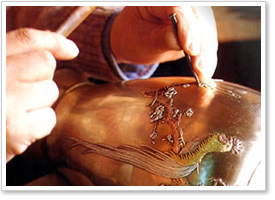It is in the Yayoi Era (from the mid 10th century to the mid 3rd century B.C.) that metalworking and use of metal implements began in Japan. In the Kofun Era (from the mid 3rd century to the end of the 7th century A.C.), the creation of various objects from copper mirrors, harnesses, accessories and others contributed to the development of metalworking techniques such as toreutics, hammering, and chasing, and it is thought that it is in this era that these techniques were established. In the Nara Era (from 710 to 794 A.C.), as represented by the construction of the “large statue of Buddha” in Todaiji Temple, foundry technology developed and metalworking, hammering and other techniques improved, which dramatically accelerated the development of metal-working technology. In the following Heian Era (from 794 to 1185 A.C.), metalsmiths moved from Nara to Kyoto, producing a lot of metal crafts and, after that, extending their techniques to armouries, coins, and even large foundry pieces. At this time, like other crafts, metal crafts also shifted from Chinese style to a purely Japanese style.

In such history, Kyoto, which was the center of Japanese culture and politics for a long time, attracted and accumulated many technologies and techniques, which have been handed down to us today. In recent years, once again, contrary to the global-scale technological evolution, the crafts of Kyoto artisans have been gaining attention as inimitable craftsmanship. It is the manufacturing technology of skilled artisans that cannot be achieved by machinery. Even in this nanotechnology age, many core technologies are often supported by traditional handiwork. It is probably not completely unrelated to this climate that has embraced such history and tradition that quite a few leading global manufacturing companies are based in Kyoto. However, because of the low visibility of the craftsmanship and the changing economic structure, there are not enough successors and the valuable techniques are in danger.